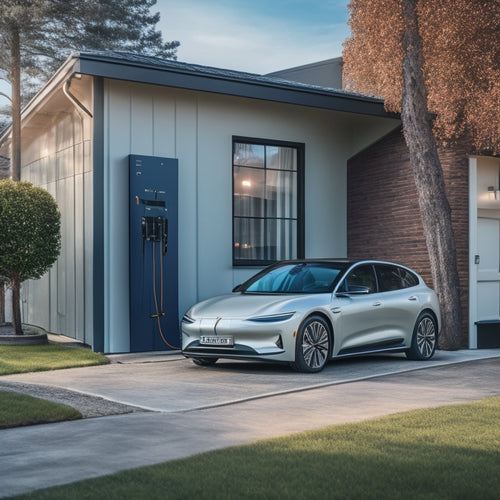
5 Essential Tips for Home Inverter Efficiency
Share
You can optimize your home's inverter efficiency by following five essential tips. First, accurately calculate your home's energy requirements to guarantee proper inverter sizing and capacity. Next, monitor energy production and consumption patterns to identify opportunities for optimization. Proper installation by a qualified installer is also critical, including correct grounding techniques and electrical inspections. Regular maintenance, including routine checks and firmware updates, is important. Finally, maximize your energy harvesting potential by adjusting panel angles, minimizing shading, and utilizing real-time monitoring. By implementing these tips, you'll be well on your way to reducing energy waste and saving on electricity bills - and there's more to discover.
Key Takeaways
• Accurately calculate your home's energy requirements to ensure the inverter capacity matches your energy needs.
• Conduct regular maintenance checks every 6-12 months to identify potential issues and optimize performance.
• Select an inverter with high efficiency ratings and adjust panel angles to match your location's latitude for maximum energy harvesting.
• Ensure proper installation by a qualified installer with experience in solar installations, and conduct thorough electrical inspections.
• Monitor energy production and consumption patterns in real-time to make data-driven decisions and reduce energy waste.
Optimizing Inverter Sizing and Capacity
When sizing your inverter, accurately calculating your home's energy requirements is vital to guarantee the system operates within its capacity. You'll want to perform a thorough load analysis to determine the total power consumption of your appliances, lighting, and other electrical devices. This involves identifying the maximum power draw of each device, as well as their individual energy requirements.
By doing so, you'll be able to determine the minimum inverter capacity required to support your energy needs. Inverter matching is critical in this process, as it ensures the inverter can handle the total load of your home. A mismatch between the inverter's capacity and your energy requirements can lead to reduced efficiency, equipment damage, or even complete system failure.
To ensure peak performance, consider the peak power demand of your home, taking into account factors like simultaneous appliance usage and seasonal energy fluctuations. By accurately sizing your inverter, you'll be able to maximize its efficiency, reduce energy waste, and enjoy reliable power supply to your home.
Monitoring Energy Production and Consumption
By tracking your home's energy production and consumption patterns, you can identify opportunities to optimize your inverter's performance and make data-driven decisions to reduce energy waste.
Monitoring your energy production and consumption is essential to guarantee your inverter is running efficiently. With energy tracking, you can pinpoint areas where energy is being wasted and take corrective action.
Here are three key benefits of monitoring energy production and consumption:
-
Accurate energy tracking: Get real-time data on your energy production and consumption to identify areas of inefficiency.
-
Data analysis: Analyze your energy usage patterns to optimize your inverter's performance and reduce energy waste.
-
Informed decision-making: Make data-driven decisions to adjust your energy usage habits and optimize your inverter's performance.
Ensuring Proper Inverter Installation
Proper inverter installation is essential to ensuring your system operates efficiently and safely. It starts with selecting a qualified installer who can assess your home's energy requirements and install the inverter accordingly. You want to make sure your installer is experienced in solar installations and familiar with local building codes and regulations.
During the installation process, it's important to focus on proper grounding techniques to prevent electrical shocks and ensure the system operates safely. A thorough electrical inspection should be conducted to identify any potential issues before the installation is complete. This inspection should include checks for proper wiring, circuit breaker compatibility, and surge protector installation.
Regular Maintenance and Upgrades
You should conduct routine checks on your inverter every 6-12 months to make sure it continues to operate at peak levels, identifying potential issues before they escalate into major problems. This proactive approach guarantees your inverter remains efficient, reliable, and safe.
Here are some essential maintenance tasks to include in your routine checks:
-
Battery Calibration: Ensure your inverter's battery calibration is up-to-date to optimize energy storage and prevent battery damage.
-
Firmware Updates: Regularly check for firmware updates and install them promptly to fix bugs, enhance performance, and maintain compatibility with other system components.
-
Visual Inspections: Conduct regular visual inspections to identify signs of wear, corrosion, or damage to cables, connectors, and other components.
Maximizing Energy Harvesting Potential
To maximize your inverter's energy harvesting potential, optimize your system's configuration to match your specific energy needs and available solar or wind resources. This involves careful consideration of your energy usage patterns, local climate, and available space for panel installation.
| Optimization Factor | Description | Impact on Energy Harvesting |
|---|---|---|
| Panel Angle | Adjusting panel angle to match your location's latitude | Up to 10% increase in energy harvesting |
| Shading Analysis | Identifying and minimizing shading from surrounding objects | Up to 5% increase in energy harvesting |
| Panel Cleaning | Regular cleaning to maintain peak energy absorption | Up to 2% increase in energy harvesting |
| Inverter Efficiency | Selecting an inverter with high efficiency ratings | Up to 3% increase in energy harvesting |
| System Monitoring | Real-time monitoring to identify areas for improvement | Ongoing optimization and energy harvesting increases |
Frequently Asked Questions
Can I Use a Single Inverter for Multiple Solar Panels?
You can use a single inverter for multiple solar panels, but consider the panel capacity and wiring complexity to guarantee optimal performance; matching panel voltage and current ratings with the inverter's capacity is essential for efficient energy harvesting.
Do Home Inverters Work With Dc-Powered Appliances Only?
You're wondering if home inverters are limited to DC-powered appliances only? Think again! Modern inverter technology can seamlessly convert DC power to AC, making it compatible with most appliances, while optimizing power consumption and energy efficiency.
Can I Install an Inverter in an Outdoor Environment?
When you install an inverter outdoors, you'll need to make sure it's weather-resistant and has corrosion protection to withstand harsh conditions, such as rain, dust, and extreme temperatures, to maintain peak performance and longevity.
Are Home Inverters Compatible With Energy Storage Systems?
"Did you know 70% of homes with solar panels also use energy storage systems? You can seamlessly integrate your home inverter with energy storage systems, achieving system integration and energy synergy, ensuring a reliable and efficient power supply."
Do Home Inverters Affect the Quality of Electricity Supply?
You'll be glad to know that home inverters can affect the quality of your electricity supply, potentially causing power distortion and voltage regulation issues, which may impact your appliances' performance and lifespan.
Related Posts
-

5 Essential Tips for Buying EV Charging Systems Online
When purchasing an EV charging system online, you'll want to make sure you're making an informed decision. First, det...
-

What You Need to Know About Permits and Inspections
You need to navigate the complex landscape of permits and inspections to guarantee your project complies with local z...
-

10 Best Solar Panel Options for Motorhomes Online
When choosing the best solar panel for your motorhome, consider factors like efficiency, durability, and design. You'...


